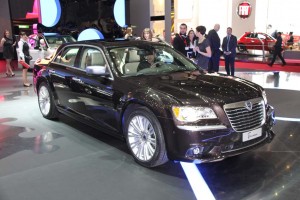Euro-American automaker Fiat/Chrysler will sharply pare back but not kill off its long-troubled Lancia brand, company officials clarified, countering recent reports that the marque would soon vanish due to Fiat’s financial problems.
But, in many ways, the “new” Lancia will be a mostly American brand despite its Italian name and heritage.
“Lancia’s lifeline will be Chrysler,” explains analyst Jim Hall, of 2953 Analytics.
TheDetroitBureau.com was one of many media outlets to interpret comments made by Fiat/Chrysler CEO Sergio Marchionne to imply Lancia would be eliminated. The brand has suffered years of declining sales despite the addition of new models and the financial strain was worsening just as Fiat has had to deal with the decline of European automotive sales. The collapse has been especially severe in its home Italian market.
But Lancia will continue to operate – just not in the way it has in the past, clarified company senior spokesman Gualberto Ranieri.
Virtually the entire current Fiat line-up developed in Italy will be abandoned. The one clear exception will be the mini-compact Lancia Ypsilon. The “rest of portfolio (will be) jointly developed with Chrysler Brand and made in North America,” Ranieri explained in response to a query from TheDetroitBureau.com.
That transition is already underway, in fact, with American-made products such as the Chrysler 300 sold in most of Europe as the Lancia Thema. Canadian-made minivans are also being sold in Europe, replacing the old Lancia people-move.
“They’ve converged vehicles,” explains analyst Hall. “There’s a blurred line here.”
It is, incidentally, possible, that the one remaining true Italian product in the Lancia line-up could make it to the U.S., the Ypsilon’s Delta platform serving as the foundation for a long-discussed Chrysler 100 minicar. But Hall does not foresee that until 2015, if the project is approved. And, as with the Fiat-derived platform used for the new Dodge Dart, it could be revised significantly to reflect American tastes.
The melding of Fiat and Chrysler products was something that CEO Marchionne actually signaled during a day-long session for media and analysts in November 2009. And it is in line with the globalization strategy of most other major makers, from Ford to Volkswagen to Toyota.
Chrysler had been a virtual non-player outside the U.S. since the 1970s but has long hoped to go global to benefit from the increased economies of scale – and because that could help offset downturns in the U.S. market. In fact, the maker’s strong growth at home – with October marking the 31st consecutive month of year-over-year sales gains – has helped offset Fiat’s problems in Europe.
But Marchionne’s strategy is to minimize the presence of the Chrysler brand in Europe to focus on the Fiat side’s better-known brand names.
There’s one exception: the U.K. Lancia, in particular, does not resonate well with English motorists, so Lancia will be downplayed there and the maker will market its products there under the Chrysler name, notes Hall.

